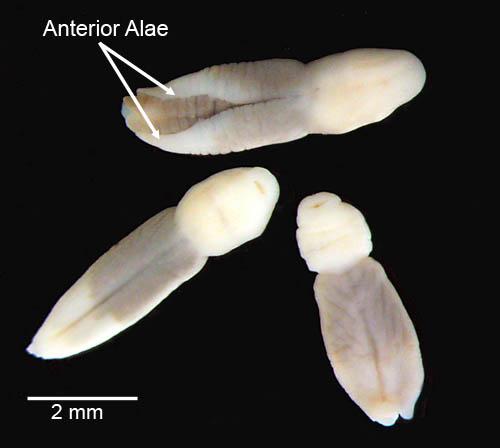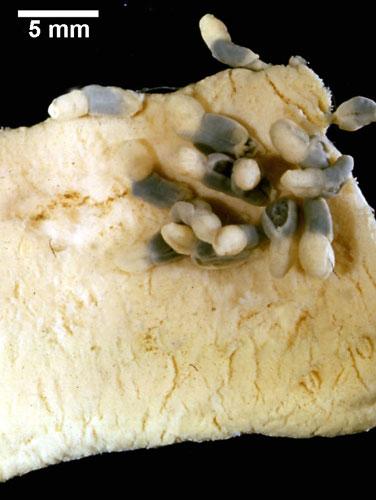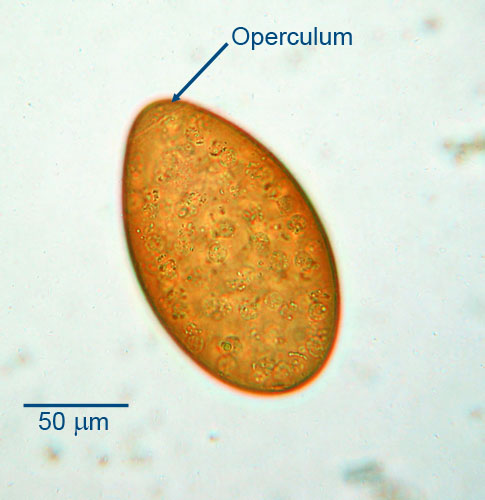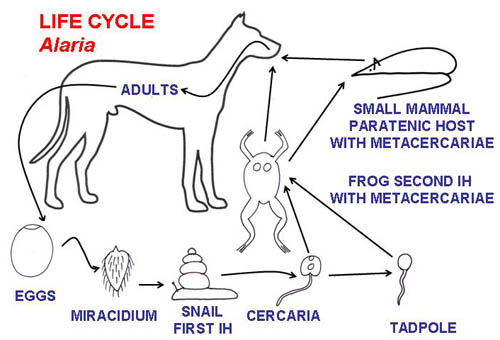
Alaria species
Alaria species are intestinal trematodes of domestic dogs and occasionally cats, and of free-ranging canids and felids.
Summary
Taxonomy
Phylum: Platyhelminthes
Class: Trematoda
Subclass: Digenea
Order: Strigeatida
Family: Diplostomidae
Alaria is the only fluke within the Family Diplostomidae that is significant in veterinary medicine. In common with other digenean flukes, Alaria has an indirect life cycle involving a molluscan intermediate host.
The exact identity of the one or more species of Alaria infecting dogs in western Canada is not known, although A. arisemoides and A. americana have been reported in wild canids in Canada. Alaria marcianae occurs in domestic cats and other carnivores in the United States and elsewhere, but has not been reported from cats in Canada.
Note: Our understanding of the taxonomy of parasites is constantly evolving. The taxonomy described in wcvmlearnaboutparasites is based on Deplazes et al. eds. Parasitology in Veterinary Medicine, Wageningen Academic Publishers, 2016.
Morphology

Alaria are up to 6 mm in length and fleshy. Their most obvious characteristics are two wing-like alae that arise dorsally and envelop the anterior end of the fluke (although they are commonly called legs). Sometimes the oral and perhaps the mid-body ventral suckers are visible to the naked eye, but even in fixed and stained specimens, internal structures are not usually visible.
The eggs of Alaria measure approximately 100 to 130 µm by 62 to 68 µm and are characteristically golden yellow-brown in colour, with a thin, smooth shell and an operculum (lid) at one end. The larval stage within the egg is not usually visible.

Host range and geographic distribution
Flukes of the genus Alaria are common in a range of carnivores in North America and elsewhere. In Canada, the parasite is most commonly seen in dogs, especially those from northern areas. Alaria marcianae occurs in domestic cats and other carnivores in the US and elsewhere, but has not been reported from cats in Canada. The extent of transmission of Alaria species between domestic and free-ranging hosts in Canada is not known. Alaria is an occasional zoonosis, including in Canada, although people are considered to be accidental hosts in which the parasite does not fully develop.
Life cycle -- indirect

Adult Alaria are located in the small intestine of the definitive host and, like most other flukes, are hermaphrodites, and eggs produced by sexual reproduction are shed in the feces. In an aquatic environment, a miracidium (first larval stage) develops within each egg and, following opening of the operculum, is released into the water.
For the life cycle to continue, the miracidium must penetrate the skin of a suitable snail first intermediate host, in which a sporocyst, then rediae, then many cercariae develop via asexual reproduction. When a cercaria leaves the snail, for the life cycle to continue it must penetrate the skin of a tadpole or frog second intermediate host, where it develops to a mesocercariae (infective larval stage and equivalent to metacercaria for other flukes). If a tadpole is infected, the parasite will persist and remain infective through to the adult frog stage. If an infected frog is eaten by a small mammal paratenic host, the mesocercariae can survive in the tissues of the paratenic host and remain infective. Infection of the carnivore definitive host follows ingestion of an infected frog second intermediate host or a small mammal paratenic host. Following ingestion by the definitive host, the mesocercariae migrate through the abdominal and thoracic cavities and the lungs before returning to the small intestine and completing development to adults. Alaria marcianae, the species in cats, has a similar life cycle but can also be transmitted to kittens through the mother’s milk.
Epidemiology
Alaria species require aquatic snails and frogs, and sometimes small mammals, for transmission, and the parasite is likely to persist where these co-exist with infected definitive hosts, such as wild canids. Like other flukes, Alaria undergoes sexual reproduction in the definitive host and also reproduces asexually in the snail first intermediate host. Additionally, although the miracidia that hatch from the eggs are relatively fragile and short-lived, the mesocercariae in the frog can survive and remain infective for the lifespan of the frog. In cats, trans-mammary transmission of A. marcianae from mother to suckling kittens is important.
Pathology and clinical signs
Adult Alaria in their carnivore definitive hosts are not usually associated with adverse clinical effects. Rarely in cats and in people, immature flukes in the lungs may cause pathology and clinical signs.
Diagnosis
Treatment and control
There are no products approved for Alaria spp. in Canada. If, unusually, the parasite appears to be pathogenic and treatment is indicated, extralabel praziquantel may be prescribed.
Control of Alaria species relies onpreventing dogs, particularly those in rural and remote areas, from eating frogs and small mammals.
Public health significance
Rarely, human infections with Alaria have been reported. People become infected the same way dogs do, by ingestion of mesocercariae in inadequately cooked frogs or paratenic hosts. One case of Alaria in northern Ontario – associated with a large number of immature flukes in the most organs - was fatal.
Occasionally what appear to be Alaria mesocercariae have been recovered from the eyes of people, including one probable case in Saskatchewan in 2005.

